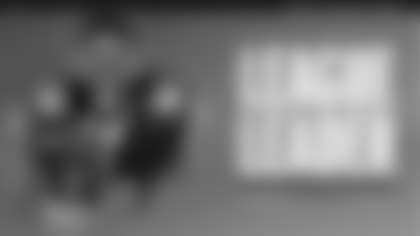One of the first things that Bears coach Matt Nagy did Wednesday at Halas Hall was meet with his assistants to discuss the day's schedule.
The conference no doubt will remain part of Nagy's morning routine throughout what likely will continue to be the most unusual year in NFL history.
With all offseason practices having been cancelled due to COVID-19, NFL teams kicking off their training camps must adhere to specific rules that were agreed upon by the league and its players association.
What makes the challenge even greater is that the requirements aren't the same for every player on the roster. For instance, Bears veterans who reported to camp last Tuesday remain in the acclimation period, which is akin to Phase 1 of the offseason program, consisting primarily of strength and conditioning work. But the rookies and quarterbacks who arrived at Halas Hall a week earlier started a ramp-up period Wednesday that's comparable to Phase 2 of the offseason program.
"Every single day is different," Nagy said Wednesday during a video call with the media. "We educate everybody and we let everybody know, 'Expect the unexpected.'
"We're not talking about hamstrings and ankles and soft-tissue injuries or just colds. We're talking about the whole COVID deal. You just never know. Every single day for the rest of the season, we're going to get a call and it's either somebody's on the list or they're not. We just have to have a bunch of contingency plans. You've got to always try to stay one or two steps ahead."
The Bears seem to be doing that. As of Wednesday, they were one of just nine NFL teams without a player on the reserve/COVID-19 list—a designation created for players who either test positive for the virus or have been in close contact with an infected person. All three players the Bears have placed on the list—defensive tackle John Jenkins, tight end Eric Saubert and running back Artavis Pierce—have been cleared and moved back to the active roster.
The Bears have gone above and beyond guidelines established by the NFL and the State of Illinois to keep their players and coaches safe. Taking advantage of a massive expansion project completed last year that more than doubled the size of Halas Hall, the Bears have redesigned high-traffic areas such as the cafeteria, locker room, training room, weight room and meeting rooms to ensure that they meet or exceed physical-distancing guidelines.
In the cafeteria, all of the tables and chairs are spaced out, and all food is individually wrapped and pre-packaged. The already-expansive locker room has been extended into the players' lounge, every other shower has been turned off, and Plexiglas and partitions have been placed between urinals and between taping tables and rehab equipment in the training room. In addition, all team meetings that were previously held in the George "Mugs" Halas Jr. auditorium have been moved to the spacious Walter Payton Center.
"We feel really good right now with our quote-unquote 'bubble' that we have here," Nagy said. "It feels very safe. There's been a lot of hard work behind the scenes to get this set-up that we have. But we're growing, too. I mean, if you came in here five days ago and looked at this complex at Halas Hall and the Water Payton Center, it's totally different. We keep adding to make it better. [General manager] Ryan [Pace] and I joked it's like one of those Wiffle balls that has all the holes in it everywhere. We keep finding holes and patching them up. That's probably going to continue for the whole year."
The safety measures the Bears have put in place for players to enter Halas Hall are extensive as well. After checking their temperature twice at home—it cannot be higher than 100.4 degrees—they log into an app and answer four questions. If their answers are appropriate, they'll be granted access to the facility.
After arriving at Halas Hall, those who need to be tested head to a Bio-Reference trailer outside the facility. Those permitted to enter the building do so through an automatic door. As soon as they walk in, they put on a mask that must be worn at all times inside the facility and have their temperature taken by a thermal mirroring scanner. They are then given a proximity tracker to wear on their wrist that records the distance and duration between individual devices.
"We're taking this very seriously," Nagy said. "The mask deal is real. You hear a lot of people say, 'Well, you've got to treat it like everybody has [COVID-19].' In my opinion, you've got to treat it like you have it, right? If you treat it like you have it, you wear your mask and the percentages of spreading it can be a lot lower. When you treat it like you have it, that means everybody has their mask on in this building, and that's what you're seeing with a lot of the teams having low test rates with positive tests, and that's how we're going about it."
Nagy has been pleased with how vigilant players have been about wearing their masks.
"Our guys have been really phenomenal with it," he said. "They see it. And we police each other, too. If somebody doesn't have their mask up, it's usually not intentional—this is new to us, there's a lot of guys that haven't been used to wearing masks—so whether it's a player, a coach, a staff member, we walk by and everybody in this building has the authority to tell you to get your mask up. We're well-stocked, and that's the way we're attacking this thing."







